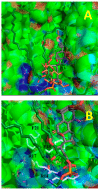Interaction of Terminal Oxidases with Amphipathic Molecules
- PMID: 37047401
- PMCID: PMC10095113
- DOI: 10.3390/ijms24076428
Interaction of Terminal Oxidases with Amphipathic Molecules
Abstract
The review focuses on recent advances regarding the effects of natural and artificial amphipathic compounds on terminal oxidases. Terminal oxidases are fascinating biomolecular devices which couple the oxidation of respiratory substrates with generation of a proton motive force used by the cell for ATP production and other needs. The role of endogenous lipids in the enzyme structure and function is highlighted. The main regularities of the interaction between the most popular detergents and terminal oxidases of various types are described. A hypothesis about the physiological regulation of mitochondrial-type enzymes by lipid-soluble ligands is considered.
Keywords: amphipathic ligands; bile acid-binding site; cytochrome oxidase; detergents; molecular bioenergetics; regulation; terminal oxidases; tight bound lipids.
Conflict of interest statement
The authors declare no conflict of interest. The funders had no role in the design of the study; in the collection, analyses, or interpretation of data; in the writing of the manuscript; or in the decision to publish the results.
Figures



Similar articles
-
Terminal Respiratory Oxidases: A Targetables Vulnerability of Mycobacterial Bioenergetics?Front Cell Infect Microbiol. 2020 Nov 23;10:589318. doi: 10.3389/fcimb.2020.589318. eCollection 2020. Front Cell Infect Microbiol. 2020. PMID: 33330134 Free PMC article. Review.
-
Substrate binding and the catalytic reactions in cbb3-type oxidases: the lipid membrane modulates ligand binding.Biochim Biophys Acta. 2010 Jun-Jul;1797(6-7):724-31. doi: 10.1016/j.bbabio.2010.03.016. Epub 2010 Mar 20. Biochim Biophys Acta. 2010. PMID: 20307490
-
The unusual redox properties of C-type oxidases.Biochim Biophys Acta. 2016 Dec;1857(12):1892-1899. doi: 10.1016/j.bbabio.2016.09.009. Epub 2016 Sep 21. Biochim Biophys Acta. 2016. PMID: 27664317
-
Characterization of two terminal oxidases in Bacillus brevis and efficiency of energy conservation of the respiratory chain.J Biochem. 1997 Nov;122(5):969-76. doi: 10.1093/oxfordjournals.jbchem.a021859. J Biochem. 1997. PMID: 9443812
-
The electrochemical properties of the highly diverse terminal oxidases from different organisms.Bioelectrochemistry. 2025 Oct;165:108946. doi: 10.1016/j.bioelechem.2025.108946. Epub 2025 Feb 21. Bioelectrochemistry. 2025. PMID: 40020283 Review.
References
-
- van der Oost J., De Boer A.P., de Gier J.W.L., Zumft W.G., Stouthamer A.H., van Spanning R.J. The heme-copper oxidase family consists of three distinct types of terminal oxidases and is related to nitric oxide reductase. FEMS Microb. Lett. 1994;121:1–9. doi: 10.1111/j.1574-6968.1994.tb07067.x. - DOI - PubMed
Publication types
MeSH terms
Substances
Grants and funding
LinkOut - more resources
Full Text Sources

